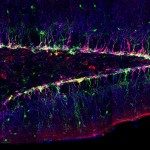Link to Pubmed [PMID] – 22491943
Development 2012 May;139(10):1874-84
In bilateria, positioning and looping of visceral organs requires proper left-right (L/R) asymmetry establishment. Recent work in Drosophila has identified a novel situs inversus gene encoding the unconventional type ID myosin (MyoID). In myoID mutant flies, the L/R axis is inverted, causing reversed looping of organs, such as the gut, spermiduct and genitalia. We have previously shown that MyoID interacts physically with β-Catenin, suggesting a role of the adherens junction in Drosophila L/R asymmetry. Here, we show that DE-Cadherin co-immunoprecipitates with MyoID and is required for MyoID L/R activity. We further demonstrate that MyoIC, a closely related unconventional type I myosin, can antagonize MyoID L/R activity by preventing its binding to adherens junction components, both in vitro and in vivo. Interestingly, DE-Cadherin inhibits MyoIC, providing a protective mechanism to MyoID function. Conditional genetic experiments indicate that DE-Cadherin, MyoIC and MyoID show temporal synchronicity for their function in L/R asymmetry. These data suggest that following MyoID recruitment by β-Catenin at the adherens junction, DE-Cadherin has a twofold effect on Drosophila L/R asymmetry by promoting MyoID activity and repressing that of MyoIC. Interestingly, the product of the vertebrate situs inversus gene inversin also physically interacts with β-Catenin, suggesting that the adherens junction might serve as a conserved platform for determinants to establish L/R asymmetry both in vertebrates and invertebrates.

